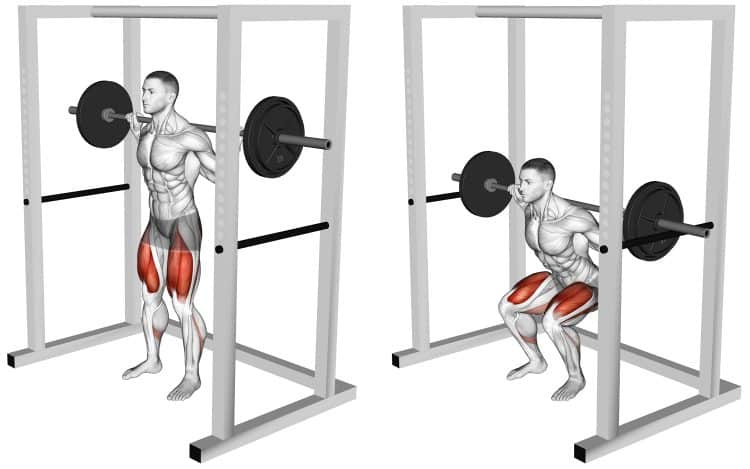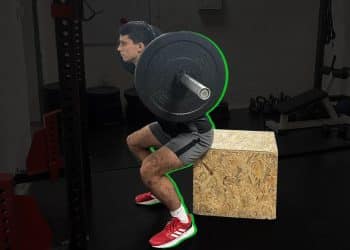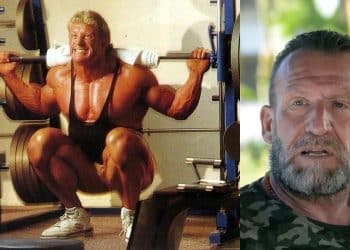The squat is known as the king of exercises, and that’s a title it undoubtedly deserves. No exercise has the potential to build muscle like the squat, and it’s a must-do for boosting athletic performance, too.
So, whatever you are training for, be that strength, muscle size, or even fat loss, squats deserve a place in your workout.
But the squat is more than just an exercise – it’s also a movement pattern. And as such, there are many ways to incorporate squats into your workouts. Great squatting exercises include:
- Barbell back squat
- Low bar squat
- High bar squat
- Front squat
- Safety bar squat
- Overhead squat
- Goblet squat
- Squat jump
- Smith machine squat
- Hack squat
- Dumbbell squat, etc., etc.
And now we’ve got another squat exercise to tell you about – pin squats. This exercise is a cross between box squats and paused squats and is a real quads killer and strength builder.
We reveal why and how to do pin squats, plus the best variations and alternatives for this great exercise.
Pin Squat – Muscles Worked
Pin squats are a compound exercise. In anatomical terms, that means they involve two joints moving simultaneously and using several muscles. Pin squats work your entire lower body and a few muscles in the upper body, too.
Level Up Your Fitness: Join our 💪 strong community in Fitness Volt Newsletter. Get daily inspiration, expert-backed workouts, nutrition tips, the latest in strength sports, and the support you need to reach your goals. Subscribe for free!

The most important muscles trained during pin squats are:
Quadriceps
Located on the front of your thighs, the quads are arguably the most dominant muscle group during pin squats. There are four quadriceps muscles – the rectus femoris, vastus lateralis, vastus medialis, and vastus intermedius. These muscles work together to extend your knees, and the rectus femoris is also a hip flexor.
Gluteus maximus
The gluteus maximus, known as the glutes for short, is the largest muscle in the human body. It’s located on the back of your hips and is your primary hip extensor muscle. The deeper you squat, the more active the glutes become. As well as extending your hips, the glutes play a part in the external rotation of the femur.
Hamstrings
The hamstrings are located on the back of your thighs. There are three hamstring muscles – the biceps femoris, semimembranosus, and semitendinosus. The hamstrings work with your glutes to extend your hip and also flex your knees. However, while your hamstrings are involved in pin squats, they’re not as active as the quadriceps.
Adductors
The adductors draw your femurs in toward the midline of your body, which is an anatomical movement called adduction. The three adductor muscles are longus, brevis, and magnus, which means longest, shortest, and biggest. The adductors are basically your inner thigh muscles. Their role during pin squats is stabilizing your hips and stopping your thighs from falling outward.
Abductors
The abductors are located on the outside of your hips and thighs. During pin squats, these muscles stabilize your femurs and prevent them from falling inward. The abductor muscles are the gluteus minimus, gluteus medius, and tensor fascia latae.
Core
Core is the collective term for the muscles of your midsection. Encircling your waist like a corset or weightlifting belt, these muscles stabilize your lumbar spine to keep it optimally aligned. The main core muscles are the rectus abdominis, obliques, and transverse abdominis.
Erector spinae
The erector spinae is a group of muscles that run up either side of your spine. During pin squats, they work with your core to stabilize your lower back. This is a crucial role given that, with a weight resting on your shoulders, the lower back has a tendency to round, especially when training with heavy loads.
How to Do Pin Squats
Get more from pin squats while keeping your risk of injury to a minimum by following these guidelines:
- Set the safety pins on your squat rack so that the barbell will touch them when you hit parallel or just below.
- Standing in the squat rack, rest and hold the barbell across your upper traps and not on your neck. Alternatively, hold the bar a little lower, i.e., across your shoulders, which is the low bar position.
- Unrack the bar and adopt your usual squat stance. Brace your core, lift your chest, and look straight ahead.
- Bend your legs and descend under control until the bar lightly touches and then rests on the safety bar. Let the weight settle fully on the pins, but do let it to come off your back. Take care not to round your lower back or relax your core.
- Next, drive your feet into the floor and stand up explosively.
- Reset your core at the top of each rep and repeat.
Pin squat pro tips:
- Adjust the height according you’re your ideal squat depth. Go less than or deeper than parallel according to your mobility and knee health.
- This exercise works best with low reps and heavy weights – 1-5 using 85% or more of your one-repetition maximum or 1RM being a good range for most.
- Wear squat shoes with raised heels to keep your shins more vertical and make squatting to parallel or below easier.
- Wear a weightlifting belt to increase core stiffness and lift more weight.
- For powerlifters, set the safety bars a little lower than your usual squat depth to make hitting parallel in competition feel more comfortable.
- Reduce the height of the safety bars by one hole per week or so to increase your squat depth and range of motion.
- No squat rack? Try Smith machine pin squats:
Pin Squat Benefits and Drawbacks
Not sure if pin squats deserve a place in your workouts? Consider these benefits and then decide!
Increase power “out of the hole”
Powerlifters call the bottom position of a squat “the hole,” and it can be a tough place to get out of! Pin squats teach you to burst out of the hole, making you less likely to get stuck at the bottom of a squat. This could also increase your vertical jump height.
Keep you honest
Pin squats ensure you hit the same depth each time you squat. You can’t half-rep a pin squat! If your squat depth tends to vary from set to set, pin squats will help keep you consistent and ensure that you always descend to the same level.
Increased time under tension
Descending slowly and pausing at the bottom of each rep increases your time under tension or TUT for short. A longer TUT makes your workouts more challenging and potentially better for increasing muscle size. Also, a longer TUT means you may not need to use as much weight for your workouts, as every rep is harder.
Train to failure safely
Using a squat rack means you can train to failure without worrying about getting trapped under a heavy weight. You can just descend and let the bar rest on the pins when your muscles fail. Duck out from under it and escape unscathed.
Learn to squat deeper
Initially, you may find it hard to squat all the way down to parallel. In that case, raise the pins to a more comfortable height. Gradually, week by week, lower the height of the pins and work on squatting a little deeper. In time, you should find that your squat depth increases, and you become more comfortable descending to parallel or even lower.
A useful rehab exercise
Knee and hip injuries may mean you cannot squat to full depth. Using pin squats allows you to control how deep you squat and gradually increase your range of motion as your injury begins to heel. This is especially useful for tendinopathy-related problems.
While pin squats are a mostly beneficial exercise, there are also a few drawbacks to consider:
Level Up Your Fitness: Join our 💪 strong community in Fitness Volt Newsletter. Get daily inspiration, expert-backed workouts, nutrition tips, the latest in strength sports, and the support you need to reach your goals. Subscribe for free!
You need a suitable squat rack
You can’t do pin squats without a squat rack or in a rack fitted with side safety straps instead of bars. As such, this exercise may not be possible in some gyms. Don’t worry, though; there are several alternatives you can use instead.
Back stress
There is a tendency to relax at the bottom of pin squats and then shock load your spine when you drive the weight back up. Because of this, you MUST stay tight between reps and keep your core engaged. Also, do not allow the bar to come off your back when it’s resting on the pins.
You can cheat by leaning forward
The aim of the pin squat is to descend until your barbell rests on the safety pins. However, you can lower the bar by leaning forward instead of squatting down, giving the impression of squatting to depth. Avoid this by keeping your chest up and making sure you use your knees more than your hips to descend. Don’t turn pin squats into pin good-mornings!
5 Pin Squat Variations and Alternatives
Pin Squats are a highly effective lower body exercise, but that doesn’t mean you need to do it all the time. There are several variations and alternatives you can use to keep your workouts productive and interesting:
1. Paused squat
Paused squats are a lot like pin squats, but instead of resting the bar on the pins of your squat rack, you maintain the bottom position of your squat using pure muscle strength. This is a good option for anyone without a squat rack and an excellent exercise for lower-body hypertrophy.
Steps:
- Rack and hold your barbell across your upper back. Step out and into your usual squat stance. Brace your core.
- Bend your legs and squat down to your preferred squat depth.
- Keeping your core tight, hold this position for 2-3 seconds. Do NOT relax!
- Drive your feet into the floor and stand up explosively.
- Reset your core and repeat for the required number of reps.
Muscles targeted:
- Primary: Quadriceps, gluteus maximus, hamstrings.
- Secondary: Abductors, adductors, core.
Benefits:
- No squat rack required.
- An excellent hypertrophy exercise.
- Increase squat power out of the hole
- A good exercise for increasing jumping power and height.
Tips:
- Adjust squat depth based on your mobility and knee health.
- Stay tight at the bottom of each rep.
- Use knee sleeves to protect your joints.
- Use a narrower stance to emphasize your quadriceps and a broader stance to hit your hips and glutes harder.
2. Box squat
Box squats work a lot like pin squats, but instead of resting the barbell on the bars of a squat rack, you rest your butt on a low box or bench. The box squat is a popular accessory exercise in powerlifting. Like pin squats, it’s designed to break up the eccentric/concentric phases of the squat to build strength and power out of the hole.
Steps:
- Place a box or bench inside your squat rack. The height of the box/bench should allow you to reach parallel when your butt touches it.
- With your back to your box, rest and hold your barbell on your upper back and adopt your usual squat stance. Brace your core, and pull your shoulders down and back.
- Bend your legs and descend until your butt is resting on the box. Let the weight settle but do not relax.
- Drive your feet into the floor and stand back up.
- Reset your core and repeat.
Muscles targeted:
- Primary: Quadriceps, gluteus maximus, hamstrings.
- Secondary: Abductors, adductors, core.
Benefits:
- An effective exercise for building strength and power out of a deep squat.
- Makes sure you always squat to the same depth.
- Increases time under tension for increased muscle growth, especially in the posterior chain.
Tips:
- Use a soft-top box, if available, to avoid jarring and shock-loading your spine.
- Experiment with a narrow, medium, and wide stance to see which you prefer.
- You can also do front box squats, which are more quads-centric, like this:
3. Anderson squat
The Anderson squat, also known as bottoms-up squats, are named after legendary weightlifter and strongman Paul Anderson, one of the strongest men who ever lived. Anderson used this method to increase his squat depth and power.
Steps:
- Adjust the height of your squat rack safety bars so that, when your barbell rests on them, your thighs are roughly parallel to the floor.
- Duck under the bar and get into the bottom position of your squat. Brace your abs and tense your entire body for lift-of.
- Drive your feet into the floor and stand up as powerfully as possible.
- Bend your legs and squat down until the bar rests on the safety pins.
- Pause for a second and repeat.
- Finish your set with the bar resting on the safety pins.
Muscles targeted:
- Primary: Quadriceps, gluteus maximus, hamstrings.
- Secondary: Abductors, adductors, core.
Benefits:
- Teaches you how to be more powerful and explosive.
- Helps develop better mobility for deeper squats.
- A popular powerlifting accessory exercise.
Tips:
- Don’t go too low too soon; this is a demanding exercise and takes some getting used to!
- Lower your safety bars gradually as you get stronger and more mobile.
- You can also do Anderson front squats, like this:
4. Pin front squat
Pins squats with the bar on your back work well, but you can have too much of a good thing. Switching to front squats hits your quads harder and lets you maintain a more upright torso, which takes stress off your lower back. Try this option if you are getting bored of regular pin squats.
Steps:
- Set the safety pins on your squat rack so that the barbell will touch them when you hit parallel or just below.
- Standing in the squat rack, rest and hold the barbell across the fronts of your shoulders. Hold it with an overhand, shoulder-width grip, upper arms parallel to the floor.
- Unrack the bar and adopt your usual squat stance. Brace your core, lift your chest, and look straight ahead.
- Bend your legs and descend under control until the bar lightly touches and then rests on the safety bar. Let the weight settle fully on the pins, but do not allow it to come off your back. Take care not to round your lower back or relax your core.
- Next, drive your feet into the floor and stand up explosively.
- Reset your core at the top of each rep and repeat.
Muscles targeted:
- Primary: Quadriceps, gluteus maximus, hamstrings.
- Secondary: Abductors, adductors, core.
Benefits:
- A very quads-centric exercise that’s ideal for building bigger, stronger thighs.
- More quads engagement than back pin squats.
- More transference to athletic activities, e.g., vertical jumps.
Tips:
- Wear weightlifting shoes or place your heels on blocks to squat deeper and keep your torso more upright.
- Stretch your lats and triceps between sets to make it easier to keep your upper arms up.
- Use lifting straps if you cannot get a good grip on the bar. This can be an issue if you have big biceps or stiff shoulders.
5. Squat with chains
Combining barbell training with resistance chains is called accommodating resistance. In simple terms, the load on your muscles increases as you extend your limbs and decreases as you bend them. Like pin squats, doing squats with chains teaches you how to explode up and out of the hole, albeit without needing to pause mid-rep.
Steps:
- Load your barbell and hang your chains from the ends. Remember to account for the weight of the chains in your weight calculations.
- Duck under the bar and rest and hold it across your upper back. Brace your core.
- Unrack the bar and adopt your usual squat stance.
- Squat down until your thighs are parallel to the floor. The chain will gather on the floor, reducing the weight on your back.
- Drive up and out of the squat, using speed and momentum to overcome the increasing load.
- Lock out, reset your core, and repeat.
Muscles targeted:
- Primary: Quadriceps, gluteus maximus, hamstrings.
- Secondary: Abductors, adductors, core.
Benefits:
- An effective way to overload the top part of your squat.
- Teaches you to drive up and out of the hole and past your sticking point.
- A badass training method – training with chains rocks!
Tips:
- Start with light chains and reduce the load on your bar – this exercise is more strenuous than it looks.
- Set the safety bars on your squat rack to avoid getting pinned under a heavy weight.
- No chains? No problem! You can achieve a similar effect with strong resistance bands, like this:
Pin Squat FAQs
Do you have a question about pin squats or leg training in general? No sweat – we’ve got the information you seek!
1. What rep range works best for pin squats?
While you could conceivably do medium to high rep sets of pin squats, they work best with low reps and heavy weights. Done this way, pin squats will build strength and power, which is arguably the best purpose of this exercise.
Also, doing lower reps means you can really focus on blasting the bar off the pins, which will make the exercise more productive.
If you really want to do higher rep, lighter weight pin squats, do them after a few heavy weight, low rep sets, so you get the most from this potent power and strength builder.
2. I don’t have access to a power rack or barbell, so what can I do instead?
No squat rack? No problem! You can achieve a similar effect by doing paused goblet squats. While not as taxing as pin squats, this variation will produce many of the same benefits. To do paused goblet squats:
- Hold a dumbbell or kettlebell in front of your chest, just under your chin. Tuck your upper arms into your sides for strength and stability.
- Step out and into your preferred squat stance. Brace your core.
- Squat down until your thighs are roughly parallel to the floor.
- Hold this position for 2-3 seconds, taking care NOT to relax. Keep your torso upright.
- Drive your feet into the floor and explosively stand up.
- That’s one rep – keep going!
3. Can I do pin squats with a safety squat bar?
Pin squats work GREAT with a safety squat bar. Because of the position of the load, safety bar pin squats feel like a cross between front squats and back squats. The handles take the pressure up your shoulders, and the built-in bar pads make for a very comfortable squatting experience. Safety bar pin squats are HIGHLY recommended!
4. Are pin squats a good muscle builder?
Pin squats are probably a better exercise for strength and power than they are for pure hypertrophy. They should lead to muscle growth, but that’s more of a byproduct than their specific purpose. Pin squats are more of a performance-boosting exercise than a bodybuilding movement. Conventional squats are probably a better option.
5. What other pin exercises are there?
In addition to pin squats, you can also do the following:
- Pin bench presses
- Pin overhead presses
- Rack pulls
All of these exercises work in much the same way as pin squats, albeit for different muscle groups.
Pin Squats – Wrapping Up
Pin squats are an unusual squatting variation, but that’s what makes them so valuable. Regular barbell squats work great but do them often enough, and eventually, they’ll lose some of their potency.
Replacing barbell squats with pin squats will expose your muscles to a new stimulus and help prevent boredom and plateaus. Also, pin squats will make you stronger out of the hole, which should have a positive carry-over to your general squat performance.
So, pin squats – try ‘em; you’re gonna like them!
Interested in measuring your progress? Check out our strength standards for Overhead Squat, Bench Press, Good Morning, and more.








